THIS week, my every intention was to scrutinize, investigate, and discover the somewhat intriguing and very serene aura enveloping the small village of Champagne, located at Mahaicony, some 38 miles from the city of Georgetown.
 This village is situated at a location between the Calcutta backdam and the great expanses of green pastures and wild foliage before one’s arrival at the National Rice Research Institute’s (NARI’s) rice testing and experimentation entity, minutes from the now almost desolate settlement of Burma.
This village is situated at a location between the Calcutta backdam and the great expanses of green pastures and wild foliage before one’s arrival at the National Rice Research Institute’s (NARI’s) rice testing and experimentation entity, minutes from the now almost desolate settlement of Burma.
At first glance, Champagne is just a cluster of houses haphazardly set in a village deprived of modernization. But like they say, “Never judge a book by its cover;” and so we certainly turned the pages of the very exciting novel to discover the glorious mysteries of Champagne Village.
And readers, our findings were both quite appealing and, in some cases, very disturbing.
Two for Champagne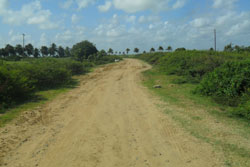 We rattled and bumped our way along, occasionally yelping in pain as the creaking old taxi dropped in and out of some virtual craters along the deplorable Burma Access Road, which we had to travel to get to Champagne Village, Mahaicony, ECD. And I was very relieved when taxi driver, Junior Abel deposited me at the first canal dam that beckoned my entry into Champagne Village.
We rattled and bumped our way along, occasionally yelping in pain as the creaking old taxi dropped in and out of some virtual craters along the deplorable Burma Access Road, which we had to travel to get to Champagne Village, Mahaicony, ECD. And I was very relieved when taxi driver, Junior Abel deposited me at the first canal dam that beckoned my entry into Champagne Village.
Since it was in the afternoon, we were greeted by the gleeful laughter of a few young girls playing hop-scotch on the main dam leading to the cluster of houses just a short distance ahead. Somewhat surprised at our entrance, the little ladies looked up sharply, sweeping us up and down, their eyes locked onto my pen, writing pad, camera and media identification card. This, I believe, prompted the soft, pleasant greetings of “Good afternoon sir,” before they resumed playing their games, glancing at us every now and then in childish curiosity.
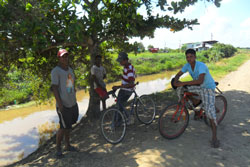 Stopping to chat with residents at the first house, a few males raised questioning eyebrows, but the two females swinging in hammocks were all welcoming smiles. One who appeared to be a grandmother mouthed with a toothless grin, “Good aftanoon uncle, wha wrang? How awe can help yuh?” My soul was instantly at ease, and with reciprocal warmth, I went into detailed explanation of the reason for my visit. This apparently excited the males, and two of them readily smoothed out their clothes, fixed their apparel, and offered to give us the grand tour of the small village.
Stopping to chat with residents at the first house, a few males raised questioning eyebrows, but the two females swinging in hammocks were all welcoming smiles. One who appeared to be a grandmother mouthed with a toothless grin, “Good aftanoon uncle, wha wrang? How awe can help yuh?” My soul was instantly at ease, and with reciprocal warmth, I went into detailed explanation of the reason for my visit. This apparently excited the males, and two of them readily smoothed out their clothes, fixed their apparel, and offered to give us the grand tour of the small village.
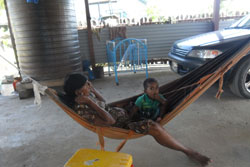 This is Champagne
This is Champagne
Well, I had thought that the cluster of houses was actually the village, but I was glad to be mistaken, since this village seemed to stretch for miles into the backdam area, where more houses, rice fields, and several farms and kitchen gardens became visible. So breathtaking was this scenery that it had me wondering why someone hadn’t discovered this most beautiful village with its full potential to become a classic tourism spectacle.
How I marvelled at the spic and span appearance of the apparently white-washed surfaces under the houses. I would later be made to understand that it was actually a mixture of cow dung, water, and a special type of mud that holds the mixture together after it has been daubed on the ground. When this dries, the appearance of the earth is so inviting as to lure one to lie down and curl up on its surface. And this mixture has a strangely alluring scent that influences a certain ‘cozy magic’ on the senses.
History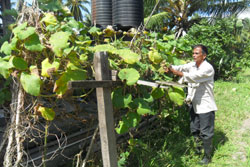 There is no village signboard to announce one’s arrival in Champagne; and strangely, no resident could give information on its history. It could also not be located on the Internet, but vegetable farmer, Jagdeo Persaud, aka “Uncle Sonny”, shared the little he knew about the location.
There is no village signboard to announce one’s arrival in Champagne; and strangely, no resident could give information on its history. It could also not be located on the Internet, but vegetable farmer, Jagdeo Persaud, aka “Uncle Sonny”, shared the little he knew about the location.
Residing there for over forty years, Persaud indicated that what is now the quaint little village was actually sprawling pastures with dense bush and foliage. Like many other countryside villages, he said, it was discovered by curious farmers who discovered the richness of the soil. Persons began to target the land firstly for small-scale rice cultivation, which eventually evolved into the very extensive rice fields that are now present. Persons soon began purchasing plots of land in the area, and gradually the village took on its appearance.
 Persaud said that, as far as he knows, the village was named by one of the very early settlers who had many plots of land there and felt that his surname was most suited for the intended village.
Persaud said that, as far as he knows, the village was named by one of the very early settlers who had many plots of land there and felt that his surname was most suited for the intended village.
Livelihood
Champagne Village is predominantly an East Indian-populated village, where pleasant and jovial residents reside in apparently perfect harmony, depending almost entirely on rice farming, cattle and poultry rearing, and vegetable cultivation for their existence.
This is evident from the many farms that stretch into the backlands, and the kitchen gardens that can be found at almost every home. Even as we drove around the village, our stomachs rumbled in Pavlovian response to the appetizing aromas that wafted towards us on the wings of some of the most refreshing breezes we have ever experienced.
 Some persons reared poultry, which provided eggs and meat for consumption; whilst a few trove on rearing very healthy cattle for sale. Strangely, there is not even one shop or grocery store in the village, and residents mentioned that they would normally journey to nearby Calcutta Village, or travel the five miles to Central Mahaicony, to obtain their groceries and household supplies.
Some persons reared poultry, which provided eggs and meat for consumption; whilst a few trove on rearing very healthy cattle for sale. Strangely, there is not even one shop or grocery store in the village, and residents mentioned that they would normally journey to nearby Calcutta Village, or travel the five miles to Central Mahaicony, to obtain their groceries and household supplies.
Undoubtedly, of all the villages I have visited, Champagne was the most appealing, with its somewhat serene simplicity.
Constraints
This state of contentment could, however, be seriously marred if several constraints facing residents are not urgently addressed.
 Mothers who were busy flipping rotis on their ‘tawahs’ or readying sweet-smelling stews for lunch disclosed that the village is engulfed for most of the day in dust caused by vehicles traversing their unpaved streets; and when the large trucks using the horribly deteriorated Burma Access Road pass — just a few rods in front of the village — they raise mammoth clouds of dust which descend on absolutely everything in their homes.
Mothers who were busy flipping rotis on their ‘tawahs’ or readying sweet-smelling stews for lunch disclosed that the village is engulfed for most of the day in dust caused by vehicles traversing their unpaved streets; and when the large trucks using the horribly deteriorated Burma Access Road pass — just a few rods in front of the village — they raise mammoth clouds of dust which descend on absolutely everything in their homes.
Husbands chomping on ‘float bakes’ or ‘sada roti’ and fried salted fish lamented that their children who attend school suffer the most, since mini-buses or cars hardly traverse the Burma Road because of its condition. Students from Champagne Village travel to either the Novar Secondary (three miles away), or the Mahaicony Secondary School, which is some five miles from their location, and they use the Burma Access Road. Lack of transportation causes students to arrive late at school almost every day, thus hampering their academic accomplishments.
 Youth discontent
Youth discontent
Speaking for a group of young men liming in the streets,
19-year-old Salim Razack noted that there is no scope for academically qualified youths in the village. He said several individuals would normally excel at the CSEC examinations, but they remain unemployed in the village, or are forced to shelve their respective ambition and engage in farming like their parents and grand-parents.
Villagers are crying out for the providence of a proper bus shed to await transportation, since the makeshift structure erected by some young men in the village does not shelter users from the scorching sun or torrential downpours.
No fun
The complaining voices of young men in the streets tugged at my heart strings as they voiced the need for recreational opportunities in the village.
Champagne Village has no playfield or fun park; and residents feel this is much needed, since it would be almost impossible to trek to Central Mahaicony or other areas to enjoy the luxuries of a well-maintained playground with at least considerable facilities.
Some mothers referred to this village as “the land that is forgotten” amidst peals of girlish laughter.
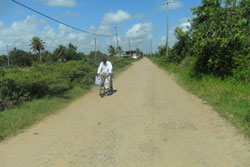 There are no nightclubs or discos in this village. There is not even a shop, and as such, villagers depend on occasional weddings and birthday parties from the forty-plus households of Champagne to “twitch their hips and roll their bellies” in dancing abandon.
There are no nightclubs or discos in this village. There is not even a shop, and as such, villagers depend on occasional weddings and birthday parties from the forty-plus households of Champagne to “twitch their hips and roll their bellies” in dancing abandon.
Rice woes
Rice farmers at Champagne are complaining of facing difficulty to obtain an adequate supply of water for their rice crops. Rice farmer Vijay Vishnu noted that, for years, they were plagued with improper drainage and irrigation, and it had resulted in major losses, not only on their rice farms, but vegetable plots as well. While he was thankful that the Mahaicony NDC body has recently dug the main canal in the village to increase the flow of water, he notes that, because of the dry weather, the low water level in this canal still affects the supply of water to rice fields, which keep expanding rapidly.
As such, farmers are forced to rent irrigation pumps for exorbitant fees to ensure that their harvests are not damaged or completely lost.
Rice farmers are also forced to solicit milling services miles away, because the Mancott Rice Milling Complex located at the back of the village was seized by a commercial bank for one reason or the other, and it actually never went into operation.
Villagers say that the large, state-of-the-art rice complex would have greatly offset their transportation costs at harvest time. What now remains is almost a shell of the complex, since, villagers noted, although there was security at the complex, a large number of expensive heavy duty equipment has been stolen by outsiders.
The village is also in dire need of maintenance in many areas, as was evident in the dense vegetation surrounding many homes and farm lands.
With its vast, majestic pastures, lush rice fields, numerous fish ponds, and sandy streets, Champagne Village takes on the pleasurable appearance of a ‘yesteryear haven’ dying to develop the potential of its beauty. It surely can become yet another ‘tourist masterpiece’ if the correct masterminds are made to discover its undisputed beauty.



.jpg)









